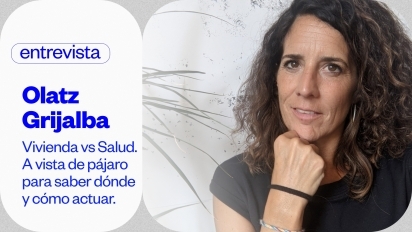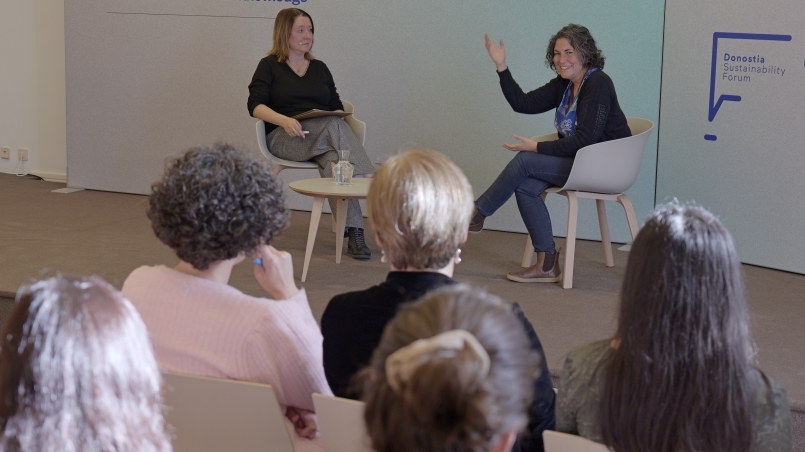Housing vs Health. A bird’s eye view on where and how to act
Risav is a system used to evaluate the situation of housing based on the health risks that could exist – both physically and psychologically – while working by the Caviar (From the initials in Spanish: Calidad de vida en arquitectura) research team. The head researcher of the project Olatz Grijalba takes part in the course centered in The difficulties of urbanism: the habitable city.

‘Until now the actions centered in an energetical rehabilitation and accessibility issues, but the real necessities are way more complex’. We have introduced ‘Health as an excuse’ in order to assess aspects such as spatial vulnerability, that is, the habitability and environmental quality in fields such as hygrothermic, lightning and acoustic comfort. While maintaining the energetic comfort, also the social aspect is integrated.
This is a tool used at municipal level and aimed at local councils so that they can design their refurbishment policies. The cadastre has been used as a cartographic base and alphanumeric data (age of the buildings, number of dwellings per doorway, dimensions, etc.). Completing this information with the analysis and classification of building typologies and various measurement and calculation processes through cartography, data that cannot be obtained directly are obtained, such as the proportion between the depth and width of the building, building orientations, whether or not there are balconies, proximity to green areas, and many others. Socio-economic aspects such as the ageing rate and its feminisation, immigration, disposable income or level of education are obtained through public statistical sources.
The study has been carried out in Donostia, where more than 60 types of buildings have been classified. To carry out the classification, aspects such as the year of construction and the height of the buildings have been taken into account, as usual, but urban morphology has been incorporated as a novelty with parameters such as density or the extent of the neighbourhood and the building form and thus, we have identified 64 building types with their various characteristics that serve to calculate the indicators.
The development of the method and the tool, as well as the analysis of Donostia was carried out in 2020 following a call from the Provincial Council of Gipuzkoa within the Gipuzkoa Science, Technology and Innovation Network programme. It is a first proposal that was presented to various departments of the city council. The results can be consulted on the website http://atlasak.datuak.net/risav
All the buildings in Donostia have been assessed for each of the indicators (habitability, hygrothermic comfort, lighting, acoustic, energy demand and social profile) with their respective vulnerability indices measured from very low to very high vulnerability on five graduation scales. In each of the areas, the "black spots" of highest and lowest vulnerability have been analysed.
The old part, parts of Egia, Intxaurrondo, Martutene and the lower part of Alza are home to the points of greatest vulnerability in the area of habitability and the lowest indices are in the new Benta Berri, Ayete, part of the Paseo de La Concha and the Paseo de Francia. These are a multitude of data that were presented to the town council and which could be of interest for the revision of the PGOU for the revision of the general urban development plan that is currently being carried out. "This general study can be perfectly useful for the design of housing policies and the rehabilitation strategy in the short and long term. They can have a 50-year vision and foresee concrete actions to address specific vulnerabilities beyond thermal insulation, which is what is currently subsidised".
The study considers physical but also mental health, so it analyses the importance of natural light in a home, the existence or not of a balcony or the possibilities of space distribution within the home, interconnected spaces or functional flexibility according to the varying needs of the people who live there. "It is relatively easy to carry out the study, but it is necessary to make visible the needs of the dwelling beyond its accessibility and its energy efficiency".
The Caviar group is currently finalising a second health assessment study taking into account the urban context of housing. "The possibilities I have to move around actively, the environmental quality of public spaces that makes me walk or not, or walk or not, or even possible sources of pollution".
In this second study they are giving special importance to the city's liveability, which enables the creation of community networks and social interaction. Aspects taking into account the ageing of the population or the problem of loneliness. "We see what the urban system is like, how diverse and vital it is because it affects our daily behaviour and therefore our health".
Olatz Grijalba said that "we often think that the more centrality or the more commerce the area has, the more vital it is, but if it is the same commerce and aimed at the same people, opens at the same hours and then it is dead... it can also be counterproductive. There are surprises, some peripheral neighbourhoods with a lot of vitality and richer than the central areas" In the case of Donostia, the Antiguo neighbourhood is an example of a mix of uses and people.
"The idea is to look for cells or urban areas that function autonomously, with basic services accessible within a 15-minute walk". There are still dormitory towns in Donostia. At the moment, the new Txomin Enea neighbourhood, a large part of Intxaurrondo and Bidebieta are residential neighbourhoods. It is also true that the policy of providing neighbourhoods with cultural and sports centres has brought about a certain balance. In the current project led by Olatz Grijalba, a rate or proportion between housing and other services or shops is being measured, and although she does not want to advance results, she does state that there are areas where almost 100% of the space is centred on housing. They are studying green areas and access to these quality green areas or the extent of the view from the window of a home, aspects already included in the first Risav study.
The Caviar research team belongs to the Department of Architecture of the UPV/EHU at the Donostia school where. Olatz Grijalba is a lecturer in the area of urban planning. Itziar Modrego and Mikel Barrena have been very active in the studio.
These studies are part of Caviar's Urban Dynamics line of work.

